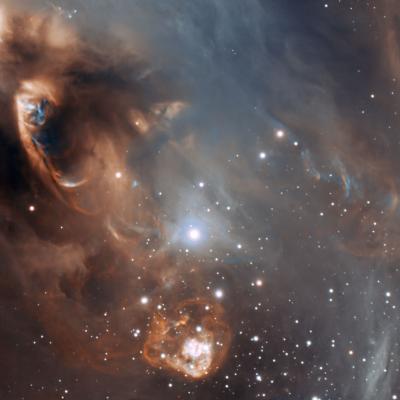Although the stars themselves are not visible to the eye, the materials they emit collide with the gas and dust clouds around them and create a surreal landscape of glowing gas, spots and streaks

A new image taken by the European Southern Observatory's Very Large Telescope provides a close-up look at the dramatic effects newborn stars have on the cloud of gas and dust from which they formed. Although the stars themselves are not visible to the eye, the materials they emit collide with the gas and dust clouds around them and create a surreal landscape of glowing gas, spots and streaks.
The star formation region NGC 6729 is one of the closest star cradles to Earth and therefore also one of the most studied. This new image, taken by ESO's Very Large Telescope, gives a close-up view of a section of this strange and impressive region. The data was selected from the ESO archive by Sergey Stepanenko as part of ESO's Hidden Treasures competition. This image of NGC 6729 came in third place in the competition.
The stars are formed deep in the molecular cloud and the initial stages of their development are not visible in visible light because they are hidden by dust. In this image you can see some young stars in the upper left part of the image. Although they are not directly visible, the commotion they create in their surroundings dominates the image. Fast jets of material move out of the young stars at speeds of about a million km/h and hit the gas surrounding them and create shock waves. These shock waves cause the gas to glow and create bright colored arcs and streaks known as Herbig-Haro objects.
In this image the Herbig-Harrow self forms two lines marking the possible direction of the material being flown. Other lines run from the top left to the bottom of the center and end in a light and dark group of spots and arcs at the bottom. The other stars near the upper left edge of the image are drawn to the center right. The bright, odd-looking formation was almost certainly formed because starlight reflected off the dust, and thus it is not the Herbig-Haru object.
This image, in enriched colors, was created using the FORS1 instrument on the Very Large Telescope. The image was taken using two different filters that isolated the light coming from the glowing hydrogen (seen here in orange) and the glowing ionized sulfur (seen in blue). The color differences in different parts of the star formation region reflect different conditions - for example, when the ionized sulfur glows strongly (the blue contours) the velocities of the material colliding with the dust are relatively low - and thus the image helps astronomers to reveal what is happening inside this dramatic arena.

6 תגובות
I remember I also did names in the delivery room
If you use Chrome, click on the image with the right mouse and in the list that opens, select the option "Open image in a new tab"
In IE there is no such option and in this case click here:
https://www.hayadan.org.il/images/content3/2011/03/eso_ngc_6729.jpg
Sorry but there are special scripts for this and it is much more convenient.
Why do I have to surf to other sites that everything is "supposed" to be here?
Make a link to the image to a new window and a larger image.
For respondents 1 and 2
Kindly click on the subtitle "for news in Universe Today"
which is at the end of the article
And they will solve and even dismiss, in the blink of an eye, all your problems that you raised in this regard.
Good luck and all the best
Agree with the first comment, the images cannot be enlarged.
You need to start putting bigger pictures!!